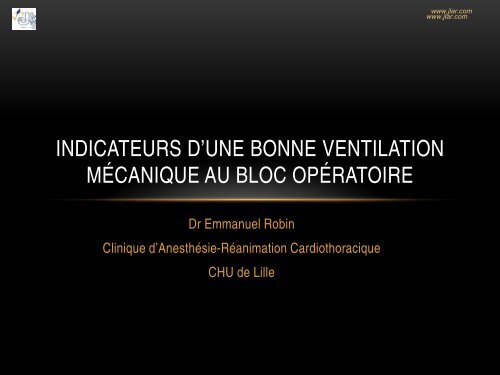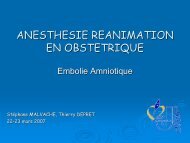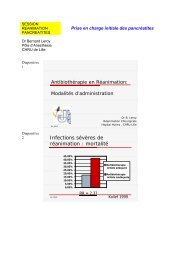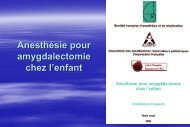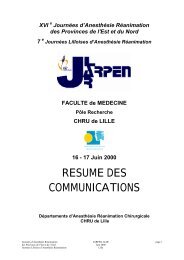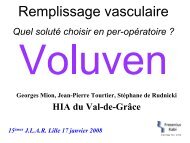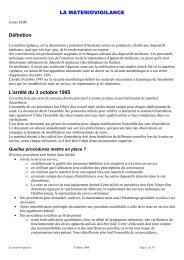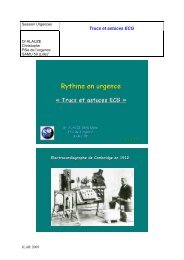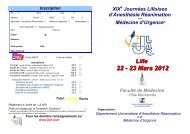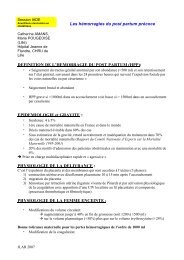Indicateurs d'une bonne ventilation en anesthésie - JLAR
Indicateurs d'une bonne ventilation en anesthésie - JLAR
Indicateurs d'une bonne ventilation en anesthésie - JLAR
You also want an ePaper? Increase the reach of your titles
YUMPU automatically turns print PDFs into web optimized ePapers that Google loves.
www.jlar.com<br />
www.jlar.com<br />
INDICATEURS D’UNE BONNE VENTILATION<br />
MÉCANIQUE AU BLOC OPÉRATOIRE<br />
Dr Emmanuel Robin<br />
Clinique d’Anesthésie-Réanimation Cardiothoracique<br />
CHU de Lille
QUELS SONT LES RECOMMANDATIONS DES<br />
SOCIÉTÉS SAVANTES (SFAR,SRLF…)<br />
www.jlar.com<br />
• Pas des confér<strong>en</strong>ce de cons<strong>en</strong>sus.<br />
• Pas de recommandation d’expert.<br />
• Pas de recommandation de <strong>bonne</strong> pratique….<br />
• Des recommandations d’experts SRLF 2005<br />
• Vt: 6-7 ml/kg (poids théorique).<br />
• PEP: quel niveau? 5-15 cmH 2 O.<br />
• Fr augm<strong>en</strong>tée (20-30/min) pour limitée l’hypercapnie.
VENTILATION MÉCANIQUE:<br />
DE MULTIPLES INDICATEURS<br />
www.jlar.com<br />
• Mécanique v<strong>en</strong>tilatoire:<br />
• Vt.<br />
• Pressions (Ppic; Pplat; PEEP).<br />
• Fr.<br />
• Analyseurs de gaz:<br />
• Fi et Fe: O 2 , CO 2 , N 2 O.<br />
• Fi et Fe des ag<strong>en</strong>ts halogénés.<br />
• Courbe de capnographie.<br />
• SpO 2 .
www.jlar.com<br />
QUEL SONT LES OBJECTIFS DE LA VENTILATION<br />
MÉCANIQUE AU BLOC OPÉRATOIRE<br />
• Assurer les échanges gazeux.<br />
• R<strong>en</strong>dre possible le geste chirurgical (ex: <strong>v<strong>en</strong>tilation</strong><br />
unipulmonaire).<br />
• Limiter l’agression afin de limiter les complications<br />
respiratoires postopératoires
BASES PHYSIOLOGIQUES DE LA VENTILATION<br />
MÉCANIQUE AU BLOC OPÉRATOIRE<br />
www.jlar.com<br />
• Décubitus dorsal (parfois décubitus v<strong>en</strong>tral ou latéral).<br />
• Effet de l’anesthésie générale.<br />
• Effet du bloc neuromusculaire.<br />
• Diminution de la CRF<br />
• Dérecrutem<strong>en</strong>t: zone postéro-inférieure<br />
• Atélectasie
ATÉLECTASIE<br />
www.jlar.com
ATÉLECTASIE: PHYSIOPATHOLOGIE<br />
www.jlar.com<br />
Anesthesiology 2005; 102:838–54
www.jlar.com<br />
ATÉLECTASIE ET ÉCHANGES GAZEUX<br />
J Appl Physiol 81:1822-1833, 1996.
www.jlar.com<br />
ATÉLECTASIE ET ÉCHANGES GAZEUX<br />
J Appl Physiol 81:1822-1833, 1996.
ATÉLECTASIE: PHYSIOPATHOLOGIE<br />
www.jlar.com<br />
• Atélectasie de compression<br />
• Atélectasie de résorption<br />
• Atélectasie par altération du surfactant
ATÉLECTASIE: PHYSIOPATHOLOGIE<br />
www.jlar.com
ATÉLECTASIE DE COMPRESSION<br />
www.jlar.com<br />
Atélectasie<br />
Volume de fermeture
ATÉLECTASIE DE COMPRESSION<br />
www.jlar.com<br />
• Effet des ag<strong>en</strong>ts anesthésiques.<br />
• Effets des curares.<br />
• Position du pati<strong>en</strong>ts.<br />
• Type de chirurgie (ex chirurgie thoracique, chirurgie abdominale,<br />
laparoscopie…).<br />
• IMC.<br />
• Antécéd<strong>en</strong>ts respiratoires.<br />
• Durée de la chirurgie.
ATÉLECTASIE DE COMPRESSION<br />
Volume de fermeture<br />
www.jlar.com<br />
BJA 1998; 81: 681-686
ATÉLECTASIE DE COMPRESSION<br />
Volume de fermeture<br />
www.jlar.com<br />
BJA 1998; 81: 681-686
www.jlar.com<br />
ATÉLECTASIE DE COMPRESSION<br />
Volume de fermeture<br />
BJA 1998; 81: 681-686
ATÉLECTASIE ET PNEUMOPÉRITOIRE<br />
www.jlar.com<br />
AG sans pneumopéritoine<br />
AG avec pneumopéritoine<br />
Anesthesiology 2005; 102:293–9
www.jlar.com<br />
ATÉLECTASIE ET PNEUMOPÉRITOIRE<br />
Anesthesiology 2005; 102:293–9
ATÉLECTASIE DE RÉSORPTION<br />
www.jlar.com<br />
Influ<strong>en</strong>ce de la composition des gaz++
ATÉLECTASIE: ATTEINTE DU SURFACTANT<br />
www.jlar.com<br />
JAP 1969; 26 (5): 571-577
www.jlar.com<br />
ATÉLECTASIE: INFLUENCE DE LA COMPOSITION<br />
DES GAZ<br />
Anesthesiology 1995; 82: 832-842
www.jlar.com<br />
ATÉLECTASIE: INFLUENCE DE LA COMPOSITION<br />
DES GAZ<br />
BJA 1995; 75: 417-421
www.jlar.com<br />
ATÉLECTASIE: TRAITEMENT<br />
Manœuvres de recrutem<strong>en</strong>t et PEEP<br />
Am J Respir Crit Care Med 2003; 167: 1620–1626.
www.jlar.com<br />
ATÉLECTASIE: TRAITEMENT<br />
Manœuvres de recrutem<strong>en</strong>t et PEEP<br />
Am J Respir Crit Care Med 2003; 167: 1620–1626.
www.jlar.com<br />
ATÉLECTASIE: TRAITEMENT<br />
Manœuvres de recrutem<strong>en</strong>t<br />
BJA 1999; 82: 551-556.
www.jlar.com<br />
ATÉLECTASIE: TRAITEMENT<br />
Manœuvres de recrutem<strong>en</strong>t ou PEEP<br />
BJA 1999; 82: 8-13.
www.jlar.com<br />
ATÉLECTASIE: TRAITEMENT CHEZ LE PATIENT<br />
OBÈSE<br />
Manœuvres de recrutem<strong>en</strong>t et/ou PEEP<br />
Anesthesiology 2009; 111:979–87
www.jlar.com<br />
ATÉLECTASIE: TRAITEMENT CHEZ LE PATIENT<br />
OBÈSE<br />
Manœuvres de recrutem<strong>en</strong>t et/ou PEEP<br />
Anesthesiology 2009; 111:979–87
ATÉLECTASIE: PRÉVENTION<br />
PATIENT OBÈSE ET LAPAROSCOPY<br />
www.jlar.com<br />
Anesthesiology 2010; 113:1310 –9
ATÉLECTASIE: PRÉVENTION<br />
PATIENT OBÈSE ET LAPAROSCOPY<br />
www.jlar.com<br />
Anesthesiology 2010; 113:1310 –9
VOLUME COURANT<br />
www.jlar.com
www.jlar.com<br />
VOLUME COURANT<br />
• Diminution du volume courant: expose au risque d’atélectasie:<br />
• New Engl J Med 1963; 269: 991-996.<br />
• JAP 1958; 14: 669-678.<br />
• Anesthesiology 1963; 24: 57-60.<br />
• Augm<strong>en</strong>tation du volume courant: expose au risque de lésions pulmonaire:<br />
• Am Rev Respir Dis 1988; 137: 1159-1164.<br />
• Am J Respir Crit Care Med 1998; 294-323.<br />
• Am J Respir Crit Care Med 1995;151:1568-75.
VOLUME COURANT ET LÉSIONS PULMONAIRES<br />
www.jlar.com<br />
Am J Respir Crit Care Med 1995;151:1568-75
PETIT VOLUME COURANT EN CHIRURGIE<br />
CARDIAQUE<br />
www.jlar.com<br />
Anesthesiology 2011; 114:1102–10
PETIT VOLUME COURANT EN CHIRURGIE<br />
CARDIAQUE<br />
www.jlar.com<br />
Anesthesiology 2011; 114:1102–10
PRESSIONS DES VOIES AÉRIENNES<br />
www.jlar.com
www.jlar.com<br />
PRESSIONS DES VOIES AÉRIENNES<br />
• Pas d’étude spécifique au cours de l’AG.<br />
• Recommandation d’expert dans le cadre du SDRA:<br />
• Pplateau < 30 cmH 2 O
MONITORAGE DE L’ETCO 2 ET CAPNOGRAMME<br />
www.jlar.com
www.jlar.com<br />
MONITORAGE DE L’ETCO 2<br />
EtCO 2<br />
• Gradi<strong>en</strong>t PaCO 2 -EtCO 2 : 3-4 mmHg pati<strong>en</strong>t éveillé.<br />
• Gradi<strong>en</strong>t PaCO 2 -EtCO 2 : 6-8 mmHg sous AG.<br />
• Augm<strong>en</strong>tation du gradi<strong>en</strong>t (> 10 mmHg):<br />
• Pathologie respiratoire: BPCO.<br />
• V<strong>en</strong>tilation unipulmonaire.<br />
Expiration<br />
Inspiration
www.jlar.com<br />
MONITORAGE DE L’ETCO 2 : CAPNOGRAMME<br />
• Décurarisation partielle.<br />
• Fuite.<br />
• Intubation sélective • Syndrome obstructif
www.jlar.com<br />
MONITORAGE DE L’ETCO 2<br />
• Chaux sodée saturée<br />
• Défaillance circulatoire sévère.<br />
• Embolie gazeuse.<br />
• Intubation oesophagi<strong>en</strong>ne.
CONCLUSION<br />
www.jlar.com<br />
• Volume courant: 8 ml/kg de poids théorique.<br />
• Pplateau < 30 cmH20.<br />
• Fréqu<strong>en</strong>ce respiratoire: 10 à 20 /min parfois plus élevée.<br />
• ETCO 2 <strong>en</strong>tre 30 et 35 mmHg <strong>en</strong> fonction du terrain.<br />
• Capnogramme non modifié.<br />
• PEEP (5-10 cmH 2 O) et manœuvres de recrutem<strong>en</strong>t (Pins 40-45 cmH 2 O)<br />
• SpO 2 > 92-95%.<br />
• Systématiquem<strong>en</strong>t??, pour quels pati<strong>en</strong>ts??:<br />
• IMC > 40?<br />
• Chirurgie thoracique?<br />
• Laparoscopie?


